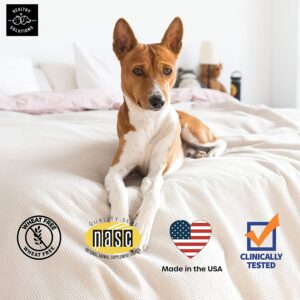Glucosamine For Dogs: What Exactly Is This Natural Compound & How Can It Dramatically Improve Mobility In Dogs?
.jpg)
Glucosamine for dogs has been recommended by veterinarians for decades to aid in joint pain and the slowing of the development of osteoarthritis…and to lessen symptoms in pets already affected.
But how does this joint supplement work, when do we use them, and more importantly, how much do you provide your dog regularly?
In this article, we’re going to answer these questions, and hopefully point you in the right direction for how to rid your dog of joint pain and inflammation with the use of glucosamine supplements.
Warning Signs Your Dog Is Struggling With Joint Pain
“He’s having a hard time getting up the stairs.”
“She’s struggling to get up and down off the floor easily.”
“He just seems like he’s slowing down a bit.”
Do any of these statements sound familiar?
If they do, it’s probably because you’ve said them to a friend, a family member, or your vet about your dog.
It can be hard to know as a dog owner what exactly the issues are, if any?
That’s why it’s vitally important that we’re able to first observe certain behavior trends, then reverse engineer to come to a valid conclusion. These are the most common behaviors we see when dogs are experiencing joint inflammation and/or pain.
Don’t think this JUST happens to senior doggies though. Although it’s uncommon for a puppy or younger dog to experience join stiffness, we’ve seen it happen on multiple occasions.
Joint health challenges are inevitable in most dog breeds at some point in time.
What if you could dramatically improve your current situation, or even get ahead of the issues before the arise, utilizing joint supplements?
A Little About the Joint
To understand what glucosamine and chondroitin are and how supplementing them in the diet can be helpful, we first have to understand just a little about the joints and joint health. Don’t worry, this won’t be super in-depth anatomy and chemistry lesson, just some basics.
The whole purpose of joint fluid, also called synovial fluid, is to lubricate the joints and make sure the bones make up the joint, like your humerus, radius, and ulna at the elbow joint for example, don’t grind on each other.
Cartilage covers the ends of bones and also provides cushion, but synovial fluid provides most of the nutrition to keep cartilage healthy. Without healthy joint fluid, cartilage can become diseased and damaged. When cartilage is damaged, the joint is not well lubricated, and bone on bone grinding occurs, leading to severe arthritis and joint pain. This is what we’re looking to slow down or prevent.
Joint fluid is made up of compounds called glycosaminoglycans. This word is a mouthful, but remember it because these compounds are vitally important. They are what makes the synovial fluid thick, viscous, and functional as a lubricant and shock absorber for the joints.
What is Glucosamine For Dogs?
Glucosamine is a natural compound found in joint cartilage. Cartilage cells use glucosamine to produce those glycosaminoglycans and keep the joint fluid healthy. Which in turn keeps the cartilage healthy.
Glucosamine also has a couple more functions. It regulates the production of collagen and proteoglycans, the two main components that make cartilage what it is. It also has some mild anti-inflammatory effects as a free radical scavenger.
What’s a free radical scavenger? To know this, you need to know what a free radical is first.
An oxygen molecule is made up of a pair of oxygen atoms. When oxygen molecules split in half, these single atoms have an extra electron in their outer shell. This “lonely” electron makes that atom behave in a very needy manner, desperately trying to find other things to bind to. These aberrant atoms are called free radicals, and their needy binding behavior causes a lot of damage to cells in the body. This is called oxidative damage or oxidative stress.
A free radical scavenger can bind and essentially deactivate these harmful free radicals. Free radical scavengers that can bind to those lonely oxygen atoms are called antioxidants.
By acting as a free radical scavenger, glucosamine for dogs can reduce inflammation and damage in the joints and throughout the rest of the body.
What is Chondroitin For Dogs?
Along with hyaluronic acid and a few other compounds, chondroitin is one of those actual glycosaminoglycans.
Found within cartilage, chondroitin is the main structural component that makes cartilage a good shock absorber and provides most of its resistance to compressive forces.
Chondroitin also helps to inhibit destructive enzymes within cartilage and joint fluid, helping to prevent arthritic changes. It also stimulates further production of glycosaminoglycans like itself, as well as those proteoglycans that are the main filler components within the latticework of cartilage.
.jpg)
When Do We Use Glucosamine and Chondroitin?
As you can see, glucosamine and chondroitin are pretty vital to our pets’ joints (and our own as well!). So it stands to reason that supplementing them in the diet could provide joint health benefits.
So in what circumstances is it best to start a glucosamine chondroitin supplement? This all largely depends on our risk for joint disease. We’ll discuss three scenarios that can help highlight when to consider using them.
Scenario 1: Glucosamine For Puppies
Let’s say we have an 8 month-old large breed puppy who starts to show signs of limping after playing. When his parents bring him to the vet and x-rays are done, early signs of hip dysplasia are seen.
In this early phase of hip dysplasia, the hip joint has a lot of laxity from a young dog’s tendons and ligaments being very elastic. This leads to the head of the femur, the “ball” of the ball and socket joint, subluxating or popping in and out with movement. This phase tends to improve by one year of age as everything tightens up with growth and we may see the limping improve on its own for some time.
However, we also know that the structural deformity of hip dysplasia will never go away and that over time, our young puppy is going to develop arthritis at an earlier age than most other dogs. Thus, we would consider starting this puppy on a glucosamine chondroitin supplement as soon as possible as a preventative to help slow this process down.
This scenario could also apply to younger dogs that sustained a traumatic fracture, a deformity in bone growth, or a problem with the proper development of one or more growth plates in bones. Really anything that can lead to arthritis later in life.
Other developmental diseases affected pups are born with other than hip dysplasia, including elbow dysplasia, osteochondritis dissecans (an inflammatory and degenerative disease of cartilage), and patellar luxation (when the kneecaps pop in and out), which can lead to chronic inflammation and pain that worsens with age.
Although we understand that you’re probably worrying about potty training, and challenges of that sort, it’s vitally important that you don’t forget about your pups joints, no matter how young!
Scenario 2: Glucosamine For Older Dogs
Now let’s say we have a 10-year-old large breed dog. She’s a bit overweight and could stand to lose about 10lb. Her parents brought her to the vet because they’ve noticed that she has started to have more difficulty standing up with her hind legs after she’s been laying down or sleeping.
Taking some x-rays shows that she has a normal-looking hip structure, but there are signs of arthritis around the hips, knees, and some other joints in the legs as well.
According to the American Animal Hospital Association (AAHA), at least 20% of dogs in the United States suffer from osteoarthritis. That’s 1 in 5 pups. And this is probably an under-represented number since many dogs can hide mild signs of arthritis for a long time.
Treating Osteoarthritis is not easy. Osteoarthritis classically presents as an initial discomfort in the joints that seems to improve after a pet starts to get moving and “works out of it”. You might see this after you wake up your senior dog from a nap to get going for a walk. The initial getting up part is hard, but once he gets going on the walk, everything seems fine.
We can also see signs of arthritis in pets that start to have difficulty with stairs, especially going down the stairs.
This particular dog was mentioned as being overweight on purpose to help highlight how important it is for joint health to keep our pets in a good, slim body condition. In this dog’s case, the extra weight has probably led to worsening signs of arthritis earlier in life.
If you feel like you’re seeing some signs of arthritis in your older dog (or even a younger dog that had some kind of predisposing injury or growth issue) starting a glucosamine chondroitin supplement can both help to provide some relief as well as slow down the degenerative inflammatory process of arthritis.
How Much Dog Glucosamine Do We Use?
Determining how much glucosamine and chondroitin to use can be a challenge due to a couple of barriers, but we’ll look to provide some guidelines. These barriers stem from three main areas.
The first is that glucosamine and chondroitin aren’t drugs, they’re supplements. This means that they have never been through the same type of rigorous dosage and efficacy studies that drugs and medications are required to pass, and there are no requirements for FDA approval before release.
The second barrier is that since glucosamine and chondroitin are not considered drugs and have no FDA approval, there is a lot of variability from product to product, making comparisons and evaluating efficacy difficult for establishing treatment doses.
The third barrier is that there is very little published scientific evidence proving that glucosamine and chondroitin work for joint support. And in the same vein, there are little published data to support a specific dosage. One study from 2007 published in The Veterinary Journal did show a statistically significant improvement in dogs with arthritis, though it did take a little over two months.
That being said, veterinarians have been recommending glucosamine for dogs for many years, which means there must be something beneficial to their use. We have what we call “anecdotal” evidence, meaning that while there may not be hard statistical data, we see the results and clinical improvements in our patients, and have for a long time. I recall firsthand seeing our 12-year-old family cat’s mobility noticeably improving after a couple of weeks of adding a glucosamine supplement to his food.
This long amount of time of recommendation and use has led to some established guidelines for dosing.
The general dosing recommendation is to start at 15-30 milligrams per kilogram per day. For an average 10lb cat, this equates to about 150 to 300mg. For a 30lb dog, this is about 200-400mg and for an 80lb dog, about 550 to 1000mg.
Anecdotal reports have also suggested starting with a higher dose initially where you essentially double the above doses. After about 4-6 weeks, if a positive response is seen, the dose can be decreased in half (to the doses provided above) or given every other day.
Fortunately, glucosamine and chondroitin have a very large safety threshold, so some tweaking at the advisement of your veterinarian to see what works best can be considered. For example, doubling the dosage during times of recovery from an injury for several weeks may be appropriate.
.jpg)
How Do I Choose The Best Joint Supplement For Dogs?
Glucosamine for dogs has been in use for a long time. So how do you choose which joint supplements are best for your pup?
Use Joint Health Supplements Made for Dogs
You can at least narrow down your search a little by using a product made with pets in mind. Forms made for pets are usually easier to administer and more palatable. Many come either in a powdered form that’s easy to mix with canned or moist food or in tasty chewable tablets.
And while quality control is still always a concern as we’ll talk about in just a second, pet dietary supplements are less likely to contain harmful artificial sweeteners like xylitol, or other concerning ingredients like garlic.
Quality Control
As we already talked about, glucosamine and chondroitin aren’t considered drugs, so FDA approval is not required for their release in a product form. This means that there is a lot of variability among products, including dosages, concentrations, and dosing recommendations.
But while there is no legally required approval of these products before release, Healthy Solutions for Pets, voluntarily choose to adhere to stricter quality control measures.
The National Animal Supplement Council (NASC) (https://nasc.cc/nasc-seal/) is a non-profit group consisting of members of the pet supplement industry that strive to maintain standards and strict levels of quality assurance with their products.
The NASC Quality Seal can only be displayed on products of companies that have voluntarily met several requirements.
- Have a quality control manual in place that ensures a consistent and quality product
- Have an adverse event reporting system in place
- Comply with very strict labeling guidelines for all products
- Provide warning or cautionary statements on labels as recommended by the FDA Center for Veterinary Medicine
- Submit to random 3rd party audits by an independent lab to ensure that product ingredients meet label claims
So when looking for any supplement for your pet, make sure to look for a product like Healthy Solutions Advanced Joint Health that displays the NASC Quality Seal, as this is the best standard in the pet supplement industry to provide a safe and quality product that matches its claims.
Lastly, look for products manufactured in the United States. While this does not guarantee safety 100%, there have been far more concerns with products manufactured overseas, especially in Asia, in regards to contaminants or toxic materials finding their way into products.
Vet-Formulated Glucosamine For Dogs Joint Supplement
Healthy Solutions Advanced Joint supplement is a veterinarian formulated and has been clinically tested* to increase activity. Helps to support healthy joints and hip flexibility. Eases aches and discomfort from daily exercise.
Clinical trials showed meaningful improvements: * In a 70 dog study, dogs on Joint Health had 2.6 greater odds of showing an increase in activity after 25 days (relative to baseline activity), compared to dogs on a placebo. Results may vary.
Active ingredients per 3 soft chews includes: Glucosamine HCl (Shellfish Source) 500 mg, Methylsulfonylmethane (MSM) 500 mg, Chondroitin Sulfate (Porcine Source) 200 mg, Green Lipped Mussel (Perna Canaliculus) 200 mg, Proprietary Enzyme Blend 130 mg (alpha-Amylase, Lipase, Cellulase, Protease, Bacillus coagulans, and Fructooligosaccharides), Boswellia serrata 90 mg, Yucca schidigera 90 mg, Calcium Ascorbate (Vitamin C) 60 mg, Zinc 7 mg, Hyaluronic Acid 5 mg, DL-alpha-tocopheryl acetate (Vitamin E) 60 IU
- Veterinarian-formulated
- Clinically tested to increase mobility
- Globally sourced ingredients so we can be sure we are finding the best available quality
- Made in California 🙂
- FDA audited, cGMP compliant facility
- Battle-tested formula & ingredient ratios
>> Get Our List of The Top 6 Best Glucosamine Supplements For Dogs In 2022
Source
You may have figured that since glucosamine and chondroitin are both natural compounds, the supplements must be sourced from natural, animal sources. Thus, it can be an important consideration for a consumer to know where these products come from.
Most glucosamine can be sourced from shellfish or synthetic sources. If derived from shellfish, make sure that these are farmed, sustainable sources.
Chondroitin can come from several sources, but primarily bovine (cows) and porcine (pigs) sources are used for most products. Shark cartilage sources may be used for some products, but consider avoiding these. While cows and pigs are technically sustainable sources, overfishing of sharks has become a significant global concern, with several species on the endangered list.
.jpg)
Ask Your Veterinarian
Because the use of glucosamine and chondroitin by veterinarians is based largely on anecdotal evidence that they work, it’s a really good idea to discuss with your pups doc which products he or she feels would work best for your furry friend and what dosage they would suggest starting with.
Summing It Up
Glucosamine and chondroitin supplements are very safe products to use, so trying one out after discussing it with your vet can’t hurt.
As with many supplements, keep your expectations with glucosamine and chondroitin realistic. Glucosamine and chondroitin are supplements, not medications, meaning they should be included as just one part of an anti-inflammatory and pain therapy regimen.
Finally, expect results to take some time. The average time frame to respond is about 4-6 weeks. The dogs in the referenced study were assessed at two months.
But as far as joint supplements go, these two natural components have been trusted for decades to assist with degenerative joint diseases and good quality products are extremely safe to use. So in essence, chat with your vet about starting a glucosamine/chondroitin supplement–it can’t hurt!

About Us
We've taken the guesswork out of caring for your pets. Our formulations are created by experienced veterinarians to address specific solutions for a variety of pet issues.
All of our products are:
As seen on:












